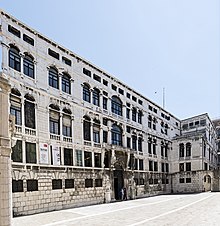
Piazza San Marco, often known in English as St Mark's Square, is the principal public square of Venice, Italy, where it is generally known just as la Piazza. The Piazzetta is an extension of the Piazza towards San Marco basin in its southeast corner. The two spaces together form the social, religious and political centre of Venice and are referred to together. This article relates to both of them.

Vincenzo Scamozzi was an Italian architect and a writer on architecture, active mainly in Vicenza and Republic of Venice area in the second half of the 16th century. He was perhaps the most important figure there between Andrea Palladio, whose unfinished projects he inherited at Palladio's death in 1580, and Baldassarre Longhena, Scamozzi's only pupil.

The Grand Canal is the largest channel in Venice, Italy, forming one of the major water-traffic corridors in the city.

The Basilica di Santa Maria Gloriosa dei Frari, commonly abbreviated to the Frari, is a church located in the Campo dei Frari at the heart of the San Polo district of Venice, Italy. It is the largest church in the city and it has the status of a minor basilica. The church is dedicated to the Assumption of Mary.

Villa Pisani at Stra refers to the monumental, late-Baroque rural palace located along the Brenta Canal at Via Doge Pisani 7 near the town of Stra, on the mainland of the Veneto, northern Italy. This villa is one of the largest examples of Villa Veneta located in the Riviera del Brenta, the canal linking Venice to Padua. The patrician Pisani family of Venice commissioned a number of villas, also known as Villa Pisani across the Venetian mainland. The villa and gardens now operate as a national museum, and the site sponsors art exhibitions.

The Museo Correr is a museum in Venice, northern Italy. Located in St. Mark's Square, Venice, it is one of the 11 civic museums run by the Fondazione Musei Civici di Venezia. The museum extends along the southside of the square on the upper floors of the Procuratorie Nuove. With its rich and varied collections, the Museo Correr covers both the art and history of Venice.

San Francesco della Vigna is a Roman Catholic church in the Sestiere of Castello in Venice, northern Italy.

The Conservatorio di Musica Benedetto Marcello di Venezia, also known as the Venice Conservatory, is a conservatory in Venice, Italy, named after composer Benedetto Marcello and established in 1876.

The House of Loredan is a Venetian noble family of supposed ancient Roman origin, which has played a significant role in shaping the history of the Mediterranean world. A political dynasty, the family has throughout the centuries produced a number of famous personalities: doges, statesmen, magnates, financiers, diplomats, procurators, military commanders, naval captains, church dignitaries, and writers.
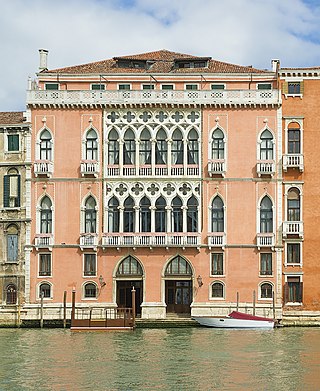
Palazzo Pisani Moretta is a palace situated along the Grand Canal in Venice, Italy, between Palazzo Tiepolo and Palazzo Barbarigo della Terrazza.

The House of Pisani is a Venetian patrician family, originating from Pisa, which played an important role in the historic, political and economic events of the Venetian Republic during the period between the 12th and the beginning of the 18th century.

Palazzo Dolfin Manin is a palace in the sestiere of San Marco on the Canal Grande of Venice, northern Italy. It is located near the Palazzo Bembo and Palazzo Dandolo Paolucci, not far from the Rialto Bridge.
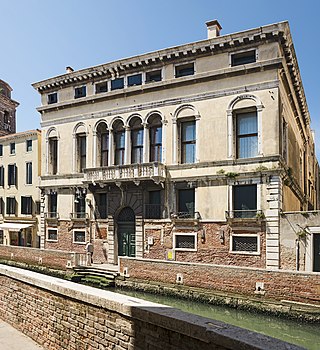
Ca Bembo is a grade-listed sixteenth-century palazzo in the parish of San Trovaso in the sestiere of Dorsoduro in Venice, Italy, noteworthy for a particularly large garden. It has, despite its name, no clear connection with the Bembo family, but a particularly strong association with one of the most prominent branches of the aristocratic Venetian family of the Barbarigo.
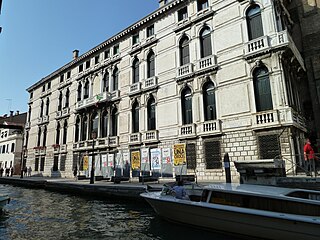
The Palazzo da Lezze or Ca' Lezze is a Baroque palace in Sestiere of Cannaregio in the city of Venice, Italy. It is located on Rio della Misericordia, with a facade on the fondamenta (canal-sidewalk), and stands between the Scuola Grande Nuova della Misericordia and Calle Largo Lezze.

Campo Sant'Angelo, also known as Campo Sant'Anzolo, is a city square in the sestiere of San Marco, in the city of Venice, Italy.

The Palazzo Pisani Gritti is a Venetian Gothic palazzo located on the north side of the Grand Canal, opposite the Church of the Salute, between the Campo del Traghetto and the Rio de l'Alboro, in the Sestieri of San Marco, Venice, Italy. It was the residence of Doge Andrea Gritti in the 16th century. It is now the Gritti Palace Hotel.

The Galleria Giorgio Franchetti alla Ca' d'Oro is an art museum located in the Ca' d'Oro on the Grand Canal in Venice, Italy.
Palazzo Pisani may refer to one of the follow Venetian palazzos:
This is an alphabetical index of people, places, things, and concepts related to or originating from the Republic of Venice. Feel free to add more, and create missing pages.
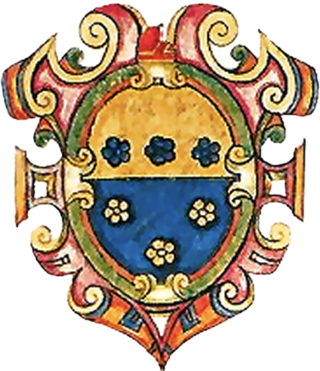
The House of Loredan-Santo Stefano was a cadet branch of the House of Loredan that existed from the 14th century until 1767. The branch was mainly settled in the Palazzo Loredan in Campo Santo Stefano, which they acquired in 1536 from the Mocenigo family. The progenitor of the branch is considered to be Gerolamo Loredan "dal Barbaro" di S. Vitale (d.~1474), father of Doge Leonardo Loredan and Dogaressa Caterina Loredan. Besides Leonardo, the branch also gave Doge Francesco Loredan.
